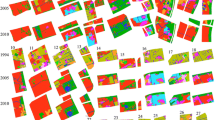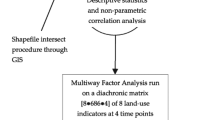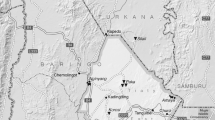Abstract
The socioeconomic causes of land use change are complex. They are highly context dependent, but most often studied through case studies. Here, we use a quasi-experimental paired block design to investigate whether better access to wage income leads to more visible land use around 28 settlements in six regions of the circumpolar Arctic. We mapped visible land use on high-resolution satellite images taken both close to the settlements, and in a more remote area of extensive land use, and payed special attention to tracks of off-road vehicles (ORV). Despite considerable differences among regions, there was an overall positive relationship between better access to wage income and land use. Reindeer herding was also associated with more visible use, in particular ORV tracks. These results suggest that access to wage income in the mixed subsistence-cash communities of the Arctic could lead to more local use related to harvesting and reindeer herding.




Similar content being viewed by others
References
Avango, D., L. Hacquebord, and U. Wrakberg. 2014. Industrial extraction of Arctic natural resources since the sixteenth century: Technoscience and geo-economics in the history of northern whaling and mining. Journal of Historical Geography 44: 15–30.
Behe, C. 2011. Subsistence fishing in the Yukon River Delta: A case study of Alakanuk subsistence fishery and the use of local/traditional ecological knowledge. La Jolla: University of California San Diego.
Bennett, M.M. 2016. Discursive, material, vertical, and extensive dimensions of post-Cold War Arctic resource extraction. Polar Geography 39: 258–273.
Brinkman, T., K.B. Maracle, J. Kelly, M. Vandyke, A. Firmin, and A. Springsteen. 2014. Impact of fuel costs on high-latitude subsistence activities. Ecology and Society 19: 9.
Buixadé Farré, A., S.R. Stephenson, L. Chen, M. Czub, Y. Dai, D. Demchev, Y. Efimov, P. Graczyk, et al. 2014. Commercial Arctic shipping through the Northeast Passage: Routes, resources, governance, technology, and infrastructure. Polar Geography 37: 298–324.
Burn Silver, S., J. Magdanz, R. Stotts, M. Berman, and G. Kofinas. 2016. Are mixed economies persistent or transitional? Evidence using social networks from Arctic Alaska. American Anthropologist 118: 121–129.
Cimon-Morin, J., M. Darveau, and M. Poulin. 2016. Consequences of delaying conservation of ecosystem services in remote landscapes prone to natural resource exploitation. Landscape Ecology 31: 825–842.
Cinner, J.E., T.R. McClanahan, M.A. MacNeil, N.A.J. Graham, T.M. Daw, A. Mukminin, D.A. Feary, A.L. Rabearisoa, et al. 2012. Comanagement of coral reef social-ecological systems. Proceedings of the National academy of Sciences of the United States of America 109: 5219–5222.
Fauchald, P., V.H. Hausner, J.I. Schmidt, and D.A. Clark. 2017. Transitions of social-ecological subsistence systems in the Arctic. International Journal of the Commons 11: 275–329.
Foley, J.A., R. DeFries, G.P. Asner, C. Barford, G. Bonan, S.R. Carpenter, F.S. Chapin, M.T. Coe, et al. 2005. Global consequences of land use. Science 309: 570–574.
Forbes, B.C., N. Fresco, A. Shvidenko, K. Danell, and F.S. Chapin. 2004. Geographic variations in anthropogenic drivers that influence the vulnerability and resilience of social-ecological systems. Ambio 33: 377–382.
Forbes, B.C., F. Stammler, T. Kumpula, N. Meschtyb, A. Pajunen, and E. Kaarlejarvi. 2009. High resilience in the Yamal-Nenets social-ecological system, West Siberian Arctic, Russia. Proceedings of the National academy of Sciences of the United States of America 106: 22041–22048.
Gonzales, R.C., and R.E. Woods. 2002. Digital image processing, 2nd ed. Boston, MA: Addison-Wesley.
Hausner, V.H., P. Fauchald, T. Tveraa, E. Pedersen, J.L. Jernsletten, B. Ulvevadet, R.A. Ims, N.G. Yoccoz, et al. 2011. The ghost of development past: The impact of economic security policies on saami pastoral ecosystems. Ecology and Society. https://doi.org/10.5751/ES-04193-160304.
Huntington, H.P., O. Anisimova, T. Christensen, T. Fenge, A.H. Hoel, T. Jung, K.B. Klokov, F. Merkel, et al. 2013. Provisioning and cultural services. In Arctic biodiversity assessment status and trends in arctic biodiversity, ed. H. Meltofte, 593–626. Akureyri: Conservation of Arctic Flora and Fauna.
Iwamura, T., E.F. Lambin, K.M. Silvius, J.B. Luzar, and J.M.V. Fragoso. 2014. Agent-based modeling of hunting and subsistence agriculture on indigenous lands: Understanding interactions between social and ecological systems. Environmental Modelling & Software 58: 109–127.
Jernsletten, J.-L., and K.B. Klokov. 2002. Sustainable reindeer husbandry. Tromsø: University of Tromsø.
Klokov, K.B. 2011. Changes in reindeer population numbers in Russia: An effect of the political context or of climate? Rangifer 32: 19–33.
Kramer, D.B., G. Urquhart, and K. Schmitt. 2009. Globalization and the connection of remote communities: A review of household effects and their biodiversity implications. Ecological Economics 68: 2897–2909.
Kumpula, T., B.C. Forbes, and F. Stammler. 2010. Remote sensing and local knowledge of hydrocarbon exploitation: The case of Bovanenkovo, Yamal Peninsula, West Siberia, Russia. Arctic 63: 165–178.
Kumpula, T., A. Pajunen, E. Kaarlejarvi, B.C. Forbes, and F. Stammler. 2011. Land use and land cover change in arctic Russia: Ecological and social implications of industrial development. Global Environmental Change-Human and Policy Dimensions 21: 550–562.
Larsen, J.N., and G. Fondahl. 2015. Arctic human development report: Regional processes and global linkages. Copenhagen: Nordisk Ministerråd.
Loring, P.A., and S.C. Gerlach. 2009. Food, culture, and human health in Alaska: An integrative health approach to food security. Environmental Science & Policy 12: 466–478.
Luzin, G.P., M. Pretes, and V.V. Vasiliev. 1994. The Kola Peninsula—Geography, history and resources. Arctic 47: 1–15.
Macdonald, J.P., S.L. Harper, A.C. Willox, V.L. Edge, and R.I.C. Government. 2013. A necessary voice: Climate change and lived experiences of youth in Rigolet, Nunatsiavut, Canada. Global Environmental Change-Human and Policy Dimensions 23: 360–371.
Maurer, G. 1992. Agriculture in the Rif and Tell mountains of North Africa. Mountain Research and Development 12: 337–347.
Meyfroidt, P. 2016. Approaches and terminology for causal analysis in land systems science. Journal of Land Use Science 11: 501–522.
Meyfroidt, P., E.F. Lambin, K.H. Erb, and T.W. Hertel. 2013. Globalization of land use: Distant drivers of land change and geographic displacement of land use. Current Opinion in Environmental Sustainability 5: 438–444.
Natcher, D., S. Shirley, T. Rodon, and C. Southcott. 2016. Constraints to wildlife harvesting among aboriginal communities in Alaska and Canada. Food Security 8: 1153–1167.
Pearce, T., J. Ford, A.C. Willox, and B. Smit. 2015. Inuit traditional ecological knowledge (TEK), subsistence hunting and adaptation to climate change in the Canadian Arctic. Arctic 68: 233–245.
R Core Team. 2017. R: A language and environment for statistical computing. Vienna, Austria: R Foundation for Statistical Comupting.
Ready, E., and E.A. Power. 2018. Why wage earners hunt. Current Anthropology 59: 74–97.
Rigby, R.A., and D.M. Stasinopoulos. 2005. Generalized additive models for location, scale and shape. Journal of the Royal Statistical Society: Series C (Applied Statistics) 54: 507–554.
Riseth, J.A. 2006. Sami reindeer herd managers: Why do they stay in a low-profit business? British Food Journal 108: 541–559.
Riseth, J.A., and A. Vatn. 2009. Modernization and pasture degradation: A comparative study of two Sami reindeer pasture regions in Norway. Land Economics 85: 87–106.
Rounsevell, M.D.A., B. Pedroli, K.H. Erb, M. Gramberger, A.G. Busck, H. Haberl, S. Kristensen, T. Kuemmerle, et al. 2012. Challenges for land system science. Land Use Policy 29: 899–910.
Slaughter, C.W., C.H. Racine, D.A. Walker, L.A. Johnson, and G. Abele. 1990. Use of off-road vehicles and mitigation of effects in Alaska permafrost environments: A review. Environmental Management 14: 63–72.
Sonter, L.J., D.J. Barrett, C.J. Moran, and B.S. Soares-Filho. 2015. A land system science meta-analysis suggests we underestimate intensive land uses in land use change dynamics. Journal of Land Use Science 10: 191–204.
Stammler, F. 2013. Narratives of adaptation and Innovation: Ways of being mobile and mobile technologies among reindeer nomadsin the Russian Arctic. In Nomadic and indigenous spaces: Productions and cognitions, ed. J. Miggelbrink, J.O. Habeck, N. Mazzullo, and P. Koch, 221–246. Dorchester, UK: Henry Ling.
Tømmervik, H., B. Johansen, K.A. Hogda, and K.B. Strann. 2012. High-resolution satellite imagery for detection of tracks and vegetation damage caused by all-terrain vehicles (ATVs) in Northern Norway. Land Degradation and Development 23: 43–52.
Vaclavik, T., F. Langerwisch, M. Cotter, J. Fick, I. Hauser, S. Hotes, J. Kamp, J. Settele, et al. 2016. Investigating potential transferability of place-based research in land system science. Environmental Research Letters 11: 095002.
van Vliet, J., N.R. Magliocca, B. Büchner, E. Cook, J.M.R. Benayas, E.C. Ellis, A. Heinimann, E. Keys, et al. 2016. Meta-studies in land use science: Current coverage and prospects. Ambio 45: 15–28.
Vasco, C., and A. Sirén. 2016. Correlates of wildlife hunting in indigenous communities in the Pastaza province, Ecuadorian Amazonia. Animal Conservation 19: 422–429.
Verburg, P.H., E.C. Ellis, and A. Letourneau. 2011. A global assessment of market accessibility and market influence for global environmental change studies. Environmental Research Letters 6: 041002.
Walker, D.A., P.J. Webber, E.F. Binnian, K.R. Everett, N.D. Lederer, E.A. Nordstrand, and M.D. Walker. 1987. Cumulative impacts of oil-fields on northern Alaskan landscapes. Science 238: 757–761.
Walker, D.A., M.K. Raynolds, F.J.A. Daniels, E. Einarsson, A. Elvebakk, W.A. Gould, A.E. Katenin, S.S. Kholod, et al. 2005. The Circumpolar Arctic vegetation map. Journal of Vegetation Science 16: 267–282.
Wenzel, G.W. 2009. Canadian Inuit subsistence and ecological instability—If the climate changes, must the Inuit? Polar Research 28: 89–99.
Young, O.R., E.F. Lambin, F. Alcock, H. Haberl, S.I. Karlsson, W.J. McConnell, T. Myint, C. Pahl-Wostl, et al. 2006. A portfolio approach to analyzing complex human-environment interactions: Institutions and land change. Ecology and Society 11: 31.
Acknowledgements
We thank the people living in the settlements we visited for providing useful background information, and Graciela Rusch and two anonymous reviewers for their contribution to improve the manuscript. This study was funded by FRAM - High North Research Centre for Climate and the Environment through the Terrestrial Flagship (Project Tundrascape) and the Flagship MIKON (Project RConnected), and by the Research Council of Norway through the project “TUNDRA” (Grant No. S192040/S30) and the Belmont Forum “Arctic Observing and Research for Sustainability” (Norwegian Research Council 247474).
Author information
Authors and Affiliations
Corresponding author
Electronic supplementary material
Below is the link to the electronic supplementary material.
Rights and permissions
About this article
Cite this article
Ehrich, D., Thuestad, A.E., Tømmervik, H. et al. Local land use associated with socio-economic development in six arctic regions. Ambio 48, 649–660 (2019). https://doi.org/10.1007/s13280-018-1095-y
Received:
Revised:
Accepted:
Published:
Issue Date:
DOI: https://doi.org/10.1007/s13280-018-1095-y




